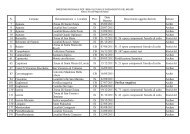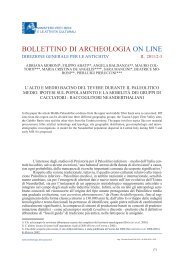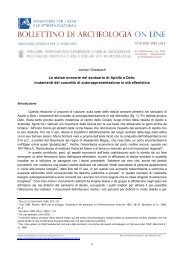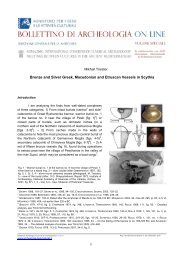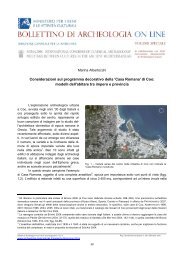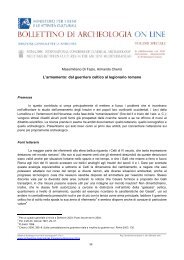Late Hellenistic Settlements in Hawrān (Southern Syria). Survival of ...
Late Hellenistic Settlements in Hawrān (Southern Syria). Survival of ...
Late Hellenistic Settlements in Hawrān (Southern Syria). Survival of ...
Create successful ePaper yourself
Turn your PDF publications into a flip-book with our unique Google optimized e-Paper software.
XVII International Congress <strong>of</strong> Classical Archaeology, Roma 22-26 Sept. 2008<br />
Session: Formation d’une culture urba<strong>in</strong>e aux marges du désert syro-arabique: espaces urba<strong>in</strong>s et périurba<strong>in</strong>s<br />
available surface. They are delimited by thick cont<strong>in</strong>uous ramparts, which follow the orography <strong>in</strong> order to<br />
maximize the defensive advantages <strong>of</strong>fered by the natural site. In most cases (Suweida, Tell Jubeh, Kreim<br />
aj-Janoûbi, Sî‘?), casemates were built <strong>in</strong>side or along the rampart. Most settlements have a more or less<br />
elaborate water management system, sometimes l<strong>in</strong>ked with the water table or a spr<strong>in</strong>g (Suweida, Kreim aj-<br />
Janoûbi), <strong>in</strong>side the walls.<br />
These common features call for comparisons with the architecture <strong>of</strong> proto-historic periods. The<br />
<strong>Hellenistic</strong> cities <strong>of</strong> Bosra and Dion owe their general form to the Middle Bronze Age tells. In Suweida, the<br />
cont<strong>in</strong>uous double rampart with casemates bears a certa<strong>in</strong> resemblance with Iron Age II cities <strong>of</strong> Palest<strong>in</strong>e,<br />
such as the f<strong>in</strong>al stratum <strong>of</strong> Beersheba 29 . In these ancient urban centres, the <strong>Hellenistic</strong> period does not<br />
signal a rupture with the orig<strong>in</strong>al layouts <strong>in</strong>herited from the Bronze and Iron Ages. Though not unattested <strong>in</strong><br />
the Near East, this strong urbanistic cont<strong>in</strong>uity between protohistoric periods and the <strong>Hellenistic</strong> phase is<br />
quite strik<strong>in</strong>g <strong>in</strong> Hawrân.<br />
More surpris<strong>in</strong>g is the fact that newly founded settlements cont<strong>in</strong>ue to adopt archaic layouts. The<br />
structure <strong>of</strong> Tell Jubeh, with its casemate wall, its wide <strong>in</strong>terior courtyard and its high citadels, is strik<strong>in</strong>gly<br />
ak<strong>in</strong> to that <strong>of</strong> some Iron Age 1 “enclosed settlements” on the plateaus <strong>of</strong> Transjordan, such as Khirbet al-<br />
Mudayna al-‘Alya on upper Wadi Mujib 30 . The oval double wall <strong>of</strong> Kreim aj-Janoûbi is rem<strong>in</strong>iscent <strong>of</strong> Bronze<br />
and Iron Age double-wall fortification systems 31 . As for Sî‘, the thick megalithic curved wall is also closer to<br />
the tradition <strong>of</strong> proto-historic ramparts than to the design <strong>of</strong> <strong>Hellenistic</strong> fortifications 32 .<br />
To the best <strong>of</strong> our knowledge, the survival <strong>of</strong> such archaic layouts until the 1 st c. AD is not common <strong>in</strong><br />
Near Eastern village architecture. In <strong>Hellenistic</strong> and Roman villages, the prevail<strong>in</strong>g mode <strong>of</strong> development<br />
seems to be characterized by the spontaneous and progressive “agglut<strong>in</strong>ation” <strong>of</strong> hous<strong>in</strong>g units with no prior<br />
plann<strong>in</strong>g 33 . When they have fortifications, these were usually built a posteriori, i.e. after the full development<br />
<strong>of</strong> the village. A similar model <strong>of</strong> development has been hypothesized for the “desert cities” previously<br />
discussed dur<strong>in</strong>g this session (Palmyra, Petra): their genesis is thought to result from the “synoikism” <strong>of</strong><br />
dispersed sub-urban nuclei, <strong>in</strong>itially quite distant from each other and grouped around tribal or familial<br />
sanctuaries 34 .<br />
On the contrary, most <strong>of</strong> the <strong>Late</strong> <strong>Hellenistic</strong> settlements <strong>of</strong> Hawrân <strong>in</strong>volve some degree <strong>of</strong> overall<br />
plann<strong>in</strong>g. Their basic morphological features suggest, for their <strong>in</strong>itial phase, a sudden, deliberate and<br />
purposeful settlement <strong>of</strong> relatively large human groups. Khirbet ‘Arish might be the only case <strong>of</strong> a<br />
spontaneous development result<strong>in</strong>g from the progressive agglut<strong>in</strong>ation <strong>of</strong> domestic units. In the other<br />
settlements, the def<strong>in</strong>ition <strong>of</strong> the settlement boundaries, clearly pre-dates the occupation <strong>of</strong> the <strong>in</strong>terior<br />
space. These sites were most probably fortified right from the beg<strong>in</strong>n<strong>in</strong>g, either with the construction <strong>of</strong> an<br />
<strong>in</strong>dependent rampart (Kreim aj-Janoûbi, Si‘) or through a specific layout <strong>of</strong> the external rooms (Tell Jubeh).<br />
Functional <strong>in</strong>terpretation<br />
In light <strong>of</strong> the specific characters <strong>of</strong> these sites with regard to contemporaneous Near Eastern<br />
urbanism and village architecture, it is more productive to th<strong>in</strong>k <strong>of</strong> their features <strong>in</strong> functional rather than <strong>in</strong><br />
“cultural” terms. From this po<strong>in</strong>t <strong>of</strong> view, both the layouts <strong>of</strong> the cities and <strong>of</strong> the villages may be considered<br />
as a response to a chronically unsafe environment. What appears at first sight is that their <strong>in</strong>habitants<br />
considered security a primary issue.<br />
29<br />
STERN ET AL. 1993, 167–173.<br />
30<br />
ROUTLEDGE 2000, fig. 4.<br />
31<br />
Double-wall fortifcation systems, usually with an <strong>in</strong>between glacis, are well known <strong>in</strong> Iron Age Palest<strong>in</strong>e and Transjordan, though at<br />
much larger sites. See for <strong>in</strong>stance Lachish IV-III (STERN ET AL. 1993, 906), Tel Batash III (STERN ET AL. 1993, 155), Tel Miqne/Ekron Ib<br />
(STERN ET AL. 1993, 1052–1057), Tel el-Hesi (STERN ET AL. 1993, 632–633), Tell Hamid (STERN ET AL. 2008, 1763), Tell el-‘Umeiri<br />
(STERN ET AL. 2008, 1849–1850). Early examples occur <strong>in</strong> the Middle Bronze Age (see e.g. Shechem: STERN ET AL. 1993, 1349).<br />
32<br />
DENTZER ET AL. 1985; VILLENEUVE Forthcom<strong>in</strong>g.<br />
33<br />
DENTZER, VILLENEUVE 1985.<br />
34<br />
For Petra, see among others DENTZER, ZAYADINE 1992; DENTZER 1999. For Palmyra see WILL 1983; DENTZER, SAUPIN 1996.<br />
Bollett<strong>in</strong>o di Archeologia on l<strong>in</strong>e I 2010/ Volume speciale G / G5 / 2 Reg. Tribunale Roma 05.08.2010 n. 330 ISSN 2039 - 0076<br />
www.archeologia.beniculturali.it<br />
7




